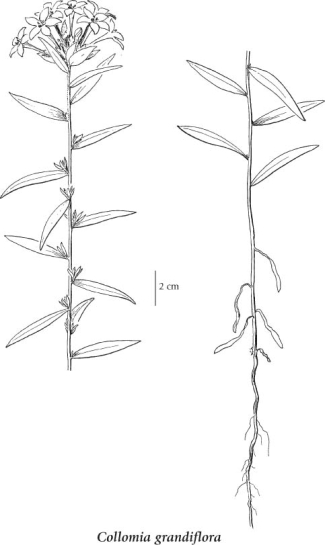Collomia grandiflora Douglas ex Lindl.
large-flowered collomia (grand collomia)
Polemoniaceae (Phlox family)
Introduction to Vascular Plants
large-flowered collomia (grand collomia)
Polemoniaceae (Phlox family)
Introduction to Vascular Plants
Photograph
© Werner Eigelsreiter (Photo ID #7136)
Species Information
General:
Annual herb from a taproot; stems erect, unbranched when small but can have axillary branches if robust, finely hairy below, long-hairy and glandular or sticky above, 0.1-1 m tall.
Leaves:
Basal leaves somewhat lobed, soon deciduous; stem leaves alternate, numerous, linear or lanceolate, 1-7 cm long, 2-13 mm wide, generally hairless above, glaucous and slightly glandular below, entire (basal somewhat lobed), the upper leaves (below the flower clusters) wider than the rest.
Flowers:
Inflorescence of 1 to several, terminal, head-like clusters of unstalked flowers; corollas salmon- pink or yellow, the slender, flaring tube 20-30 mm long, spreading to five, 5-10 mm long lobes; calyces 7-10 mm long, the five lanceolate lobes to 4 mm long; pollen generally blue.
Fruits:
Capsules, with 1-seeded chambers; seeds becoming sticky when moistened.
Illustration

If more than one illustration is available for a species (e.g., separate illustrations were provided for two subspecies) then links to the separate images will be provided below. Note that individual subspecies or varietal illustrations are not always available.
Illustration Source: The Illustrated Flora of British Columbia
Ecology
Ecological Framework for Collomia grandiflora
The table below shows the species-specific information calculated from
original data (BEC database) provided by the BC Ministry of Forests and Range.
(Updated August, 2013)
The table below shows the species-specific information calculated from
original data (BEC database) provided by the BC Ministry of Forests and Range.
(Updated August, 2013)
| Site Information |
Value / Class |
||
|
Avg |
Min |
Max |
|
| Elevation
(metres) |
810 | 810 | 810 |
| Slope
Gradient (%) |
47 | 47 | 47 |
|
Aspect (degrees) |
222 | 222 | 222 |
| Soil
Moisture Regime (SMR) [0 - very xeric; 4 - mesic; 8 - hydric] |
2 | 2 | 2 |
| Modal
Nutrient Regime
Class |
C | ||
| #
of field plots species was recorded in: |
1 | ||
| Modal
BEC Zone Class |
IDF | ||
|
All BEC Zones (# of stations/zone) species was recorded in |
IDF(1) | ||
|
Source:
Klinkenberg 2013
|
|||